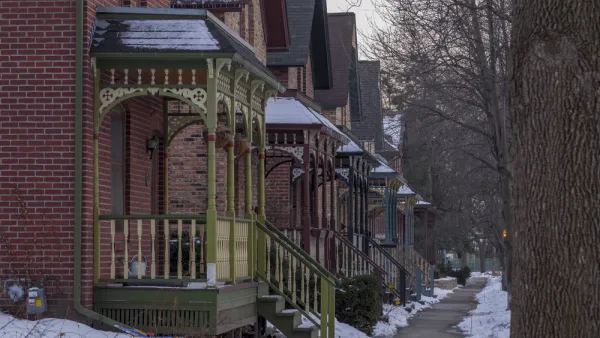Minneapolis combines prosperity with plentiful affordable housing, an increasing rarity. Geographical factors play a role, but longstanding "fiscal equalization" policies may make the difference.

Minneapolis offers mobility and career opportunities that belie its affordable housing prices. Derek Thompson puts forward "fiscal equalization," a set of laws dating from the 1970s and unique in the U.S., as prime cause of that success. The policies require "all of the region’s local governments—in Minneapolis and St. Paul and throughout their ring of suburbs—to contribute almost half of the growth in their commercial tax revenues to a regional pool, from which the money would be distributed to tax-poor areas."
On top of this public-minded redistribution, the Twin Cities benefits from its status as a regional hub, drawing talent into the metro area without suffering an outflow of workers to larger cities. Minneapolis also has no shortage of land potential for expansion. A strong, affordable economy is the result.
But that might not be the full story. Another of Minneapolis' developmental "benefits" is its demographic homogeneity. Like social success stories in northern Europe (and unlike New York, Los Angeles, Chicago) the Twin Cities has never tackled significant racial challenges. As minorities migrate into the historically white region, whether a Minneapolis miracle can prevail is up for debate.
FULL STORY: The Miracle of Minneapolis

National Parks Layoffs Will Cause Communities to Lose Billions
Thousands of essential park workers were laid off this week, just before the busy spring break season.

Retro-silient?: America’s First “Eco-burb,” The Woodlands Turns 50
A master-planned community north of Houston offers lessons on green infrastructure and resilient design, but falls short of its founder’s lofty affordability and walkability goals.

Delivering for America Plan Will Downgrade Mail Service in at Least 49.5 Percent of Zip Codes
Republican and Democrat lawmakers criticize the plan for its disproportionate negative impact on rural communities.

Test News Post 1
This is a summary

Test News Headline 46
Test for the image on the front page.

Balancing Bombs and Butterflies: How the National Guard Protects a Rare Species
The National Guard at Fort Indiantown Gap uses GIS technology and land management strategies to balance military training with conservation efforts, ensuring the survival of the rare eastern regal fritillary butterfly.
Urban Design for Planners 1: Software Tools
This six-course series explores essential urban design concepts using open source software and equips planners with the tools they need to participate fully in the urban design process.
Planning for Universal Design
Learn the tools for implementing Universal Design in planning regulations.
EMC Planning Group, Inc.
Planetizen
Planetizen
Mpact (formerly Rail~Volution)
Great Falls Development Authority, Inc.
HUDs Office of Policy Development and Research
NYU Wagner Graduate School of Public Service





























